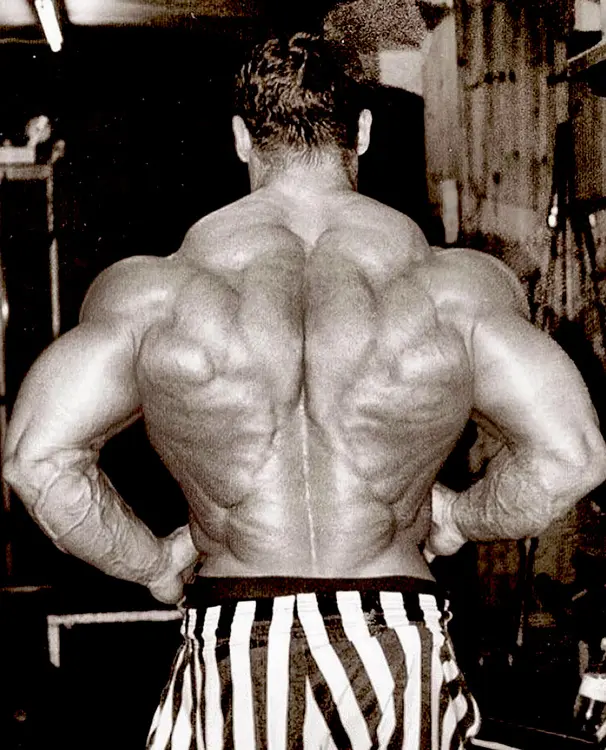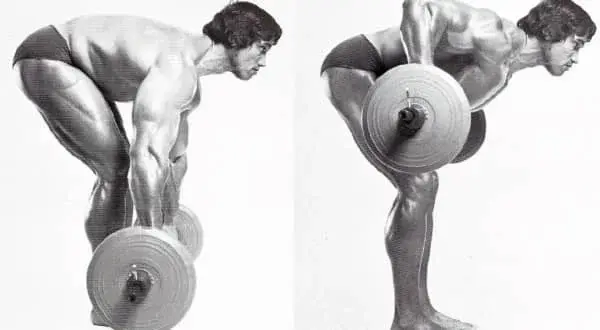Seated cable rows are a staple in almost all back workout programs. Almost every gym around the world has a variant of the rowing machine. The seated cable row is such a popular lift that it makes us wonder if people are leaving gains on the table by overlooking other incredibly effective back exercises.
Before we jump into the seated cable row alternatives, let’s dive into the anatomy of the back exercises so that we can better understand why you need to prefer some lifts over others. Being equipped with the right knowledge will help you make better decisions in the gym.
The back is one of the biggest muscle groups. A good back workout should be as exhausting (if not more) than a grueling leg workout. You should be running on fumes and crawling out of the gym after every back training session. The thought of a back workout should ignite the same anxiety and terror as a GVT squat session.
A V-tapered back is the trademark of aesthetics and symmetry. No matter how big your arms or legs are if you don’t have broad shoulders and a tight waist, your physique is never going to look proportionate. A V-tapered back will, in fact, make your muscles look bigger as it will add to the size illusion.
The Ultimate Back Workout

Your back workouts should consist of two types of movements:
- Rowing Exercises
- Pulling Exercises
Pulling exercises like lateral pulldowns, dumbbells pullovers, straight-arm pulldowns, and pull-ups help in building the width of your back. These exercises help in building a wide back and give you the V-taper. Rowing movements, on the other hand, like the seated cable rows, dumbbells, and barbell rows, help in building the thickness and girth in the back.
Level Up Your Fitness: Join our 💪 strong community in Fitness Volt Newsletter. Get daily inspiration, expert-backed workouts, nutrition tips, the latest in strength sports, and the support you need to reach your goals. Subscribe for free!
Rowing (horizontal-pulling) movements involve the recruitment of the arms, lats, and scapula. The depression and retraction of the shoulder blades train the lats, improves lower trap engagement, and strengthens the rhomboids.
Not only do the seated cable rows improve the aesthetics of your back and lats, but they can also help with posture. Many rookies make the mistake of overly relying on one kind of exercise. Either their workouts get isolation or compound exercise heavy, or they focus too much on pulling exercises and forget everything about the rowing movements.
Best Seated Cable Row Alternatives:
1. Single-Arm Dumbbell Rows

Many people lack in the back department because they can’t recruit all the muscle fibers in their lats. A big reason behind this is that, unlike your pecs or biceps, it’s hard to develop a mind-muscle connection with your back because you can’t see it in the mirror while training.
Range of motion is the other factor keeping you from achieving a solid back. Many people struggle with their form in compound back training lifts and hence aren’t able to follow a full range of motion. Performing single-arm dumbbell rows put you in the perfect spot to make the most of your back training as you’re supporting your body with one hand while you lift with the other.
How to do Single-Arm Dumbbell Rows:
- Get in position by holding a dumbbell in your right hand.
- Bend over and place your left hand on an incline bench which is set at approximately waist height or on the dumbbell rack.
- Your back should be close to parallel to the floor throughout the exercise and your feet should be directly under your hips.
- Slowly lift the dumbbell by pulling your right elbow towards the roof.
- Make sure you don’t move your right shoulder too much as it will take away the tension from the lats.
- At the bottom of the movement, the dumbbell should be only a couple of centimeters from the floor.
- Repeat for the recommended reps before switching sides.
Mods – You could also use a flat bench to perform the exercise.
Related Read: One Top-Secret Technique That Will Take Your Gains To The Next Level
2. T-Bar Rows

T-Bar rows are a classic. You should be using the T-bar machine (with the wide handle) as it’ll not only build thickness but will also add inches to your lats. If you don’t have access to a T-bar machine at your gym, you can go the old-school way and use a V-bar handle on a barbell. The advantage of this technique is that it closely mimics the seated cable row movement.
How to do T-Bar Rows:
- Bend over at your hips and grab the V-bar handle while it is placed at the neck of the barbell.
- Maintain a slight bend in your knees. (Doing so will eliminate the chances of hamstring recruitment.)
- Pull the barbell to your chest with a focus on lifting with the elbows and engaging the lats.
- Lower the weights until they almost touch the floor while targeting a deep stretch in your upper back on the eccentric motion.
It is essential to maintain strict form – bent over to a minimum of 60-degrees with a slight arch in the back – while performing the standing back exercises for optimal muscle fiber recruitment. Standing upright while performing the back exercises will result in your shoulders, traps, and biceps recruitment.
Related Read: T-Bar Row Exercise Guide
3. Standing One-Arm Cable Rows
The standing single-arm cable row will engage the muscle fibers in your back you didn’t know existed. It’ll also make you realize that you don’t always need big weights to train your back efficiently.
How to do Standing One-Arm Cable Row:
- Grab a D-handle grip while it is attached to the pulley machine at the lowest setting.
- Walk back until there is tension at arm’s length.
- Bend over and pull your elbows to your side. Contract the life out of your lats at the top of the movement.
- Return to the starting position with a slow and controlled motion.
- Repeat for the recommended repetitions.
4. Seal Rows
Most people get through their back workouts using momentum by swinging back and forth. It is especially true for people who go super heavy on the seated cable row. In the seal row, you perform the barbell row while lying on a flat bench. Doing this eliminates the probability of using momentum to complete the lift.
Level Up Your Fitness: Join our 💪 strong community in Fitness Volt Newsletter. Get daily inspiration, expert-backed workouts, nutrition tips, the latest in strength sports, and the support you need to reach your goals. Subscribe for free!
How to do Seal Rows:
- Place a couple of aerobic steps under a flat bench at both ends to lift it off the floor.
- Grab the barbell with a wider-than-shoulder grip.
- Take a deep breath and pull the barbell to your torso.
- Lower the weight to the floor while breathing out.
- The seal rows work your upper and middle back.
5. Inverted TRX Rows
Up to here in the article, we’ve covered free weight (barbell and dumbbell) and machine exercises. It’s now time for some bodyweight lifts. Inverted TRX rows are one of those exercises which look easy but can kill you when you try them for yourself. The inverted rows will work your back, shoulders, biceps, and core.
How to do Inverted TRX Rows:
- Adjust the TRX so the handles are at your torso level.
- Grab the handles and allow yourself to hang backward on extended arms.
- Get in position by walking your feet until your body is in a straight line.
- Pull your upper body upwards as your torso skims past through your elbows.
- Contract your lats and shoulder blades at the top of the movement.
- Return to the starting position in a controlled motion.
Mods: if you don’t have access to a TRX trainer at your gym, you can perform the inverted rows on a smith machine or in a squat rack with the bar placed at the abdomen level. Don’t follow a rep structure for this exercise. Instead, keep going until your muscles can take no more. The results will speak for themselves.
6. Single-Arm T-Bar Rows
This variation of the T-bar row provides better isolation and helps with greater muscle recruitment. The single-arm T-bar row is an advanced exercise and can take some time to get used to. According to a study conducted over an eight-week period, using different exercises and even their variations can ignite muscle growth and motivate you to train.
How to do Single-Arm T-Bar Rows:
- Stand with your side facing one end of a barbell.
- Get into position by bending over at your hips and maintaining a slight bend in your knees.
- Grab the end of the barbell while your arm is fully extended.
- Take a deep breath and lift the barbell until it is close to your torso.
- Return to the starting position with a controlled motion.
- Pro tip: Since the bar will be moving at an angle, it is advisable to perform a few reps with an empty bar to get the movement right.
7. Pendlay Rows
Pendlay rows have seen a rise in popularity in recent years since Instagram fitness athletes started making the lift a part of their training routines. You could think of the pendlay row as the deadlifts’ cousin. The lift targets your upper and lower back. It also requires a full posterior chain engagement and core activation for stability.

How to do Pendlay Rows:
- Throughout the exercise, your upper body should not go above a 45-degree angle.
- Stand with a barbell placed next to your shins and maintain a slight bend in your knees.
- Grab the bar with a wider-than-shoulder width grip.
- While keeping your head and neck in a neutral position, flex through the elbows to pull the bar towards your abdomen as quickly as you can.
- Contract your lats and shoulder blades at the top of the movement before returning to the starting position.
- Return the weight to a dead stop on the floor before performing the second rep.
Mod: Pendlay rows are not meant for rookies. If you’re a beginner, you’d be better off practicing basic versions of this exercise like the over or underhand barbell rows.
Read: How To Build Your Best Back Ever With Pendlay Rows
8. Quadruped Dumbbell Rows
Quadruped dumbbell rows are probably the strictest exercise on the list. Because of its limited range of motion, this lift is great for beginners, people who are going through an injury, and even people who want to lift super heavy but want to limit the chances of an injury.
How to do Quadruped Dumbbell Rows:
- Get on all fours while ensuring your back is straight, your hands are directly below your shoulders, and your knees are directly below your hips.
- Grab a dumbbell in your right hand and lift it to your side while contracting your scapula and lats.
- Slowly return the dumbbell to the starting position.
- Repeat for the recommended reps.
- Pro tip: if you lift too heavy in this exercise, you’ll lose balance if you row too far.
You could think of quadruped dumbbell rows as an easier version of renegade dumbbell rows.
9. Incline Bench Dumbbell Rows
If you’re one of those people who rocks his upper body like a metal band guitarist while performing the bent-over dumbbell row, the incline bench dumbbell row is for you. The incline dumbbell row closely replicates the movement and effects of the seated cable rows.
How to do Incline Bench Dumbbell Rows:
- Set up an incline bench at a 60-80 degree angle.
- Grab a dumbbell in each hand and place your chest on the pad.
- Lift the dumbbells to your sides by flexing at your elbows.
- Hold and contract your lats at the top of the movement.
- Return to the starting position with a controlled movement.
10. Seated Band Rows
We like to call the seated band rows – poor man’s cable rows. You don’t need dumbbells, barbells, or any machine for the seated band row. All you need is a heavy or extra-heavy strength resistance band or loops.
How to do Seated Band Rows:
- Sit on the floor with your back straight and legs extended in front of you.
- Place one end of the resistance loops around your feet and grab onto the other end with a neutral grip.
- Wrap the bands around your feet in such a manner that you feel tension while holding the bands at arm’s length.
- Pull your hands to your sides by bending at your elbows.
- Hold and squeeze your lats at the top of the movement.
- You should maintain a strict form while performing the exercise.
Conclusion
Seated cable rows are a great exercise, but you can score an aesthetically appealing and functionally robust back with bodyweight or free weight alternatives mentioned above. The exercises will get you the same results while training the same muscles and following the same movement but while reducing the stress placed on your back.
A strong back with good mobility is foundational to a solid physique. A weak back can cause many issues which might or might not be reversible. The exercises listed in the article will help you develop all aspects of your back while limiting the chances of an injury.
Interested in measuring your progress? Check out our strength standards for Pendlay Row, Pull Ups, T Bar Row, and more.








